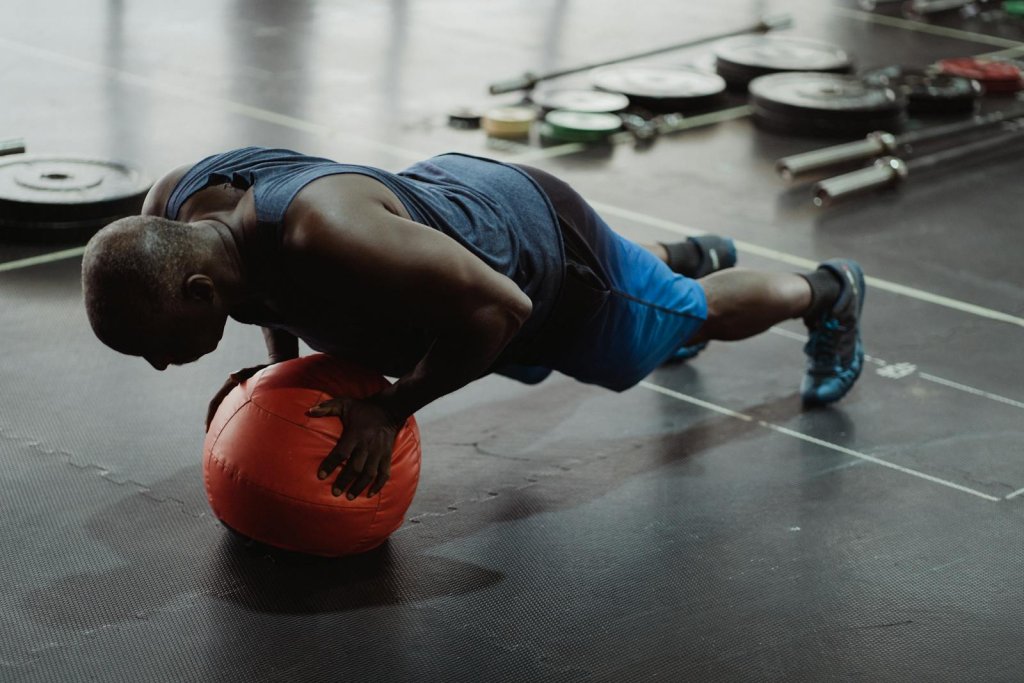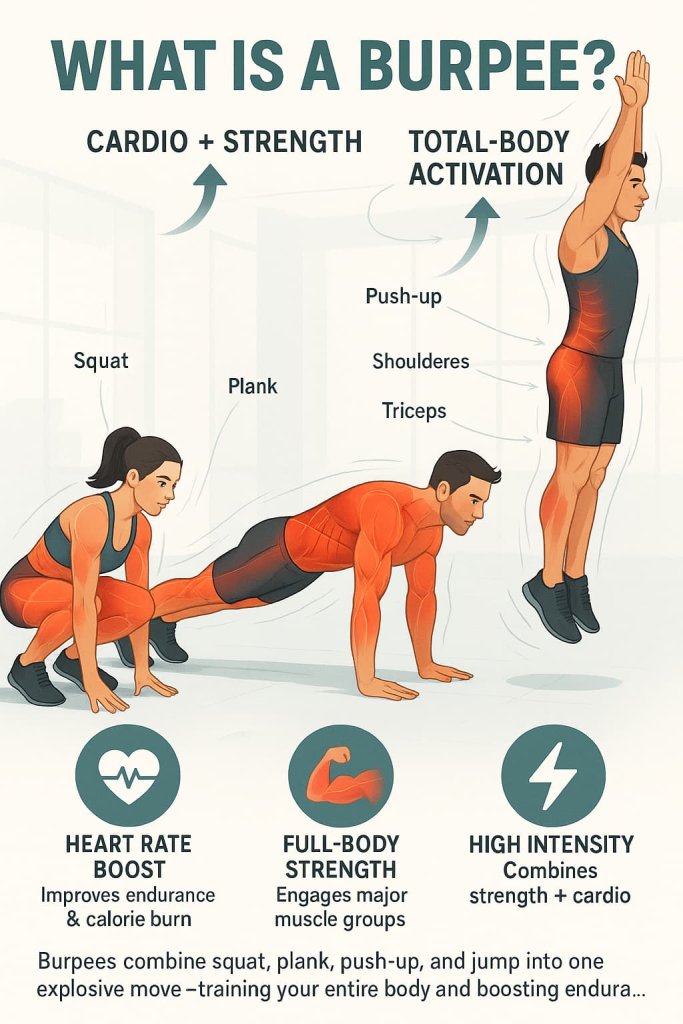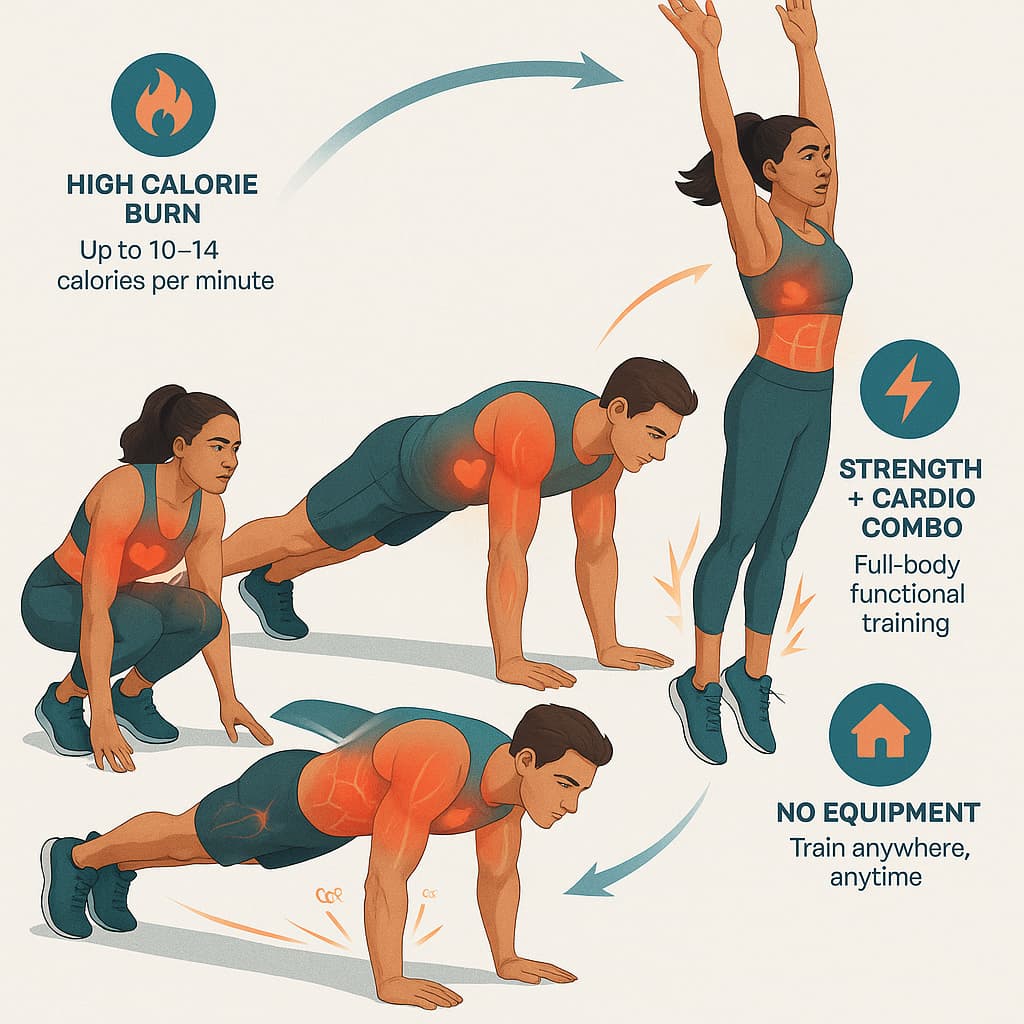Burpees are one of the most effective full-body exercises to build strength, burn fat, and boost endurance—all without equipment. This single move works your chest, arms, core, legs, and cardiovascular system simultaneously, making it a top pick for efficient training.

Whether your goal is fat loss, strength, or stamina, mastering burpee variations can transform your body and fitness level fast. This guide explains the benefits, safe technique, and 12 burpee workouts to match any level—from beginner to advanced.
What Is a Burpee?
A burpee is a compound, bodyweight movement that combines a squat, plank, push-up, and jump into one fluid sequence.

According to National Library of Medicine, burpees elevate your heart rate quickly, improving cardiovascular endurance and calorie burn. They also engage major muscle groups—glutes, quadriceps, hamstrings, chest, shoulders, triceps, and core—for total-body conditioning.
In studies published in the Journal of Human Kinetics (PMC, 2019), participants performing a 3-minute burpee test showed significant gains in strength endurance, averaging 56–57 repetitions for men and 48–49 for women, highlighting its high metabolic and muscular demand.
Why Burpees Work
Burpees deliver exceptional results because they combine strength, cardio, and coordination in one exercise.

- High Calorie Burn: A study in the Journal of Strength and Conditioning Research found that burpees burn up to 10–14 calories per minute, rivaling sprint intervals.
- Functional Fitness: Each rep challenges mobility, balance, and core stability.
- Endurance & Power: Combining jump and push phases trains fast-twitch muscle fibers and cardiovascular capacity.
- No Equipment Needed: Perfect for home or travel workouts.
However, as noted by SELF Magazine (2025), proper form is essential to prevent shoulder, knee, or lower-back strain. Beginners should master the movement slowly before increasing speed or reps.
How to Perform a Standard Burpee (Step-by-Step)
- Stand tall with feet shoulder-width apart.
- Squat down and place your hands on the floor.
- Jump or step your feet back into a plank.
- Perform one push-up (optional for beginners).
- Jump your feet back to your hands.
- Explosively jump upward, reaching overhead.
Trainer Tip: Keep your core tight, spine neutral, and land softly to absorb impact.
12 Best Burpee Workouts for Total-Body Fitness
These burpee variations target every major muscle group while challenging your endurance, coordination, and strength. From beginner-friendly options to advanced power moves, each one delivers a complete full-body workout.
1. Classic Burpee
Why it works:
The foundation of all burpee variations, this move combines strength, cardio, and endurance. It elevates heart rate quickly while targeting multiple muscle groups for total-body conditioning.
Muscles worked:
Glutes, quadriceps, hamstrings, chest, shoulders, triceps, and core.
How to do it:
- Stand with feet shoulder-width apart.
- Squat down and place your hands on the floor.
- Jump your feet back into a plank position.
- Perform a push-up (optional for beginners).
- Jump your feet back to your hands, then explode upward into a jump.
Trainer Tip:
Land softly and engage your core through the entire movement to protect your spine.
2. Half Burpee (No Jump)
Why it works:
A low-impact version ideal for beginners or recovery days. It builds strength and endurance while reducing joint stress.
Muscles worked:
Glutes, hamstrings, quads, core, and shoulders.
How to do it:
- Start standing, then squat and place hands on the floor.
- Step or jump back into a plank position.
- Step or jump your feet forward to your hands and return to standing—skip the jump.
Trainer Tip:
Keep your hips in line with your shoulders to maintain good posture and core stability.
3. Push-Up Burpee
Why it works:
Adds a strength element to the standard burpee by engaging the chest, triceps, and shoulders more intensely.
Muscles worked:
Chest, triceps, shoulders, core, and legs.
How to do it:
- Perform a standard burpee.
- After jumping your feet back, lower into a full push-up before returning to standing and jumping.
Trainer Tip:
Keep elbows at a 45° angle to your torso during the push-up to avoid shoulder strain.
4. Jump Tuck Burpee
Why it works:
A high-intensity plyometric move that builds explosive lower-body power and elevates cardiovascular demand.
Muscles worked:
Quads, glutes, hamstrings, calves, core, and shoulders.
How to do it:
- Complete a standard burpee, but as you jump up, bring your knees toward your chest (tuck jump).
- Land softly and flow into the next rep.
Trainer Tip:
Use controlled landings—knees slightly bent—to reduce impact on your joints.
5. Mountain Climber Burpee
Why it works:
Integrates dynamic core work, improving stability and endurance while enhancing coordination.
Muscles worked:
Core, hip flexors, chest, shoulders, glutes, and quads.
How to do it:
- Perform a burpee and, once in the plank position, do four fast mountain climbers (knees drive to chest).
- Jump your feet forward and explode up.
Trainer Tip:
Drive your knees quickly but keep your hips level—avoid bouncing.
6. Side-to-Side Burpee
Why it works:
Builds lateral movement strength and coordination—great for athletes and balance training.
Muscles worked:
Glutes, quads, hamstrings, adductors, abductors, core, and shoulders.
How to do it:
- Perform a burpee, then instead of jumping straight up, hop laterally to the side.
- Alternate directions with each rep.
Trainer Tip:
Keep your landing soft and your torso upright to maintain balance.
7. Burpee to Broad Jump
Why it works:
Combines explosive leg power with cardio intensity, improving athletic performance and lower-body drive.
Muscles worked:
Glutes, hamstrings, quads, calves, and core.
How to do it:
- Do a burpee, then jump forward as far as possible (broad jump).
- Turn around and repeat in the opposite direction.
Trainer Tip:
Engage your glutes and swing your arms to maximize jump distance safely.
8. Burpee with Dumbbells
Why it works:
Adds external resistance, increasing muscle activation in the upper body and core for strength development.
Muscles worked:
Chest, triceps, shoulders, glutes, quads, core, and forearms.
How to do it:
- Hold a dumbbell in each hand at your sides.
- Perform the burpee, keeping dumbbells on the ground during the plank and push-up.
- Return to standing and perform a shoulder press or jump.
Trainer Tip:
Choose light-to-moderate weights to maintain control and avoid wrist strain.
9. Box Jump Burpee
Why it works:
Amplifies power output and coordination while challenging your cardiovascular system.
Muscles worked:
Glutes, quads, hamstrings, calves, and core.
How to do it:
- Perform a burpee in front of a sturdy box or step.
- Instead of a vertical jump, leap onto the box, land softly, then step down and repeat.
Trainer Tip:
Keep knees soft during landing and ensure the box is stable and appropriate for your height.
10. Burpee Pull-Up
Why it works:
Engages the upper back and arms, adding a pulling component that balances pushing exercises.
Muscles worked:
Lats, biceps, traps, shoulders, chest, core, glutes, and quads.
How to do it:
- Stand under a pull-up bar.
- Perform a burpee, and after jumping up, grab the bar and complete one pull-up.
- Drop down carefully and repeat.
Trainer Tip:
Use a controlled pull-up motion and avoid swinging to protect your shoulders.
11. One-Leg Burpee
Why it works:
Enhances unilateral strength, balance, and coordination while activating stabilizing muscles.
Muscles worked:
Glutes, quads, hamstrings, calves, and core.
How to do it:
- Perform the entire burpee standing on one leg.
- Keep the non-working leg slightly lifted during the plank and jump phases.
- Alternate legs each set.
Trainer Tip:
Focus on balance over speed—stability builds strength.
12. 100-Burpee Challenge
Why it works:
A true test of endurance, stamina, and mental toughness—this challenge boosts aerobic and anaerobic capacity while burning major calories.
Muscles worked:
Full-body activation—chest, arms, shoulders, legs, and core.
How to do it:
- Perform 100 continuous burpees with perfect form.
- Take short rests only when needed and aim to improve your completion time over sessions.
Trainer Tip:
Pace yourself—start at a sustainable rhythm, then increase intensity toward the end.
Beginner-to-Advanced Progression Plan
| Level | Focus | Sets x Reps | Rest | Variations |
|---|---|---|---|---|
| Beginner | Form & Endurance | 3 x 10 | 60 sec | Half Burpee, Classic |
| Intermediate | Strength & Cardio | 4 x 12 | 45 sec | Push-Up, Mountain Climber |
| Advanced | Power & Speed | 5 x 15 | 30 sec | Tuck Jump, Burpee Pull-Up |
Common Mistakes to Avoid
- Dropping hips during the plank phase
- Landing with locked knees or flat feet
- Rushing through reps without maintaining form
- Skipping the warm-up or stretching afterward
Warm-Up Before Burpees
Before starting, spend 5–10 minutes preparing your body:
- Arm circles – 30 sec
- Bodyweight squats – 10 reps
- Plank shoulder taps – 10 reps
- Hip openers – 30 sec
- Light jogging or jumping jacks – 1 min
Safety Tips
- Beginners can step back instead of jumping.
- Keep your spine neutral and core braced.
- Avoid burpees if you have shoulder, wrist, or knee injuries.
- Stop immediately if you feel sharp pain or dizziness.
FAQs About Burpees
1. How many burpees should I do per day?
Start with 3 sets of 10–12 reps and increase gradually to 50–100 reps depending on fitness level.
2. Do burpees burn belly fat?
Yes—burpees help burn total body fat, which includes abdominal fat, when paired with proper nutrition and recovery.
3. Are burpees safe for beginners?
Yes, with modified versions like half burpees or stepping instead of jumping.
4. What muscles do burpees work?
They target your glutes, quads, hamstrings, core, chest, shoulders, and triceps.
5. Can I replace running with burpees?
Burpees can improve cardio fitness similarly to running, though both offer unique benefits.
6. How many calories do burpees burn?
Roughly 10–14 calories per minute, depending on intensity and body weight.
7. Should I do burpees every day?
It’s best to perform them 3–4 times per week, alternating with strength or recovery sessions.
Conclusion
Burpees are one of the most powerful total-body exercises for improving strength, endurance, and metabolism—no gym required.
Start with the basics, master your form, and progress through these 12 variations to unlock maximum fitness results fast.
Ready to challenge yourself? Try a 30-day burpee plan and see your strength and stamina soar.
References
- Polevoy G, et al. (2022). Influence of Burpee on Endurance and Short-Term Memory in Adolescents. Supports endurance benefits and potential cognitive effects.
PubMed Central - U.S. Department of Health & Human Services (2018). Physical Activity Guidelines for Americans, 2nd ed. Authoritative safety/volume framework for vigorous work like burpees.
Health.gov - American College of Sports Medicine (ACSM). Physical Activity Guidelines overview. Reinforces weekly intensity targets and resistance-training frequency.
ACSM - American Heart Association. Warm Up, Cool Down. Clear, evidence-aligned warm-up guidance for high-intensity sessions.
www.heart.org - Willis EA, et al. (2019). Energy Expenditure and Intensity of Group-Based High-Intensity Functional Training. Context for calorie burn and intensity in mixed-modal bodyweight sessions.
PubMed Central - ACSM. High-Intensity Interval Training: For Fitness, for Health or Both? Practical HIIT framing that aligns with burpee circuits.
ACSM
